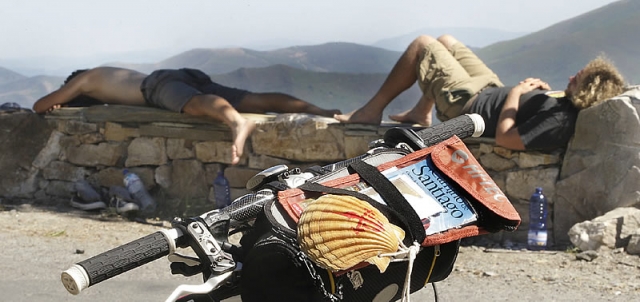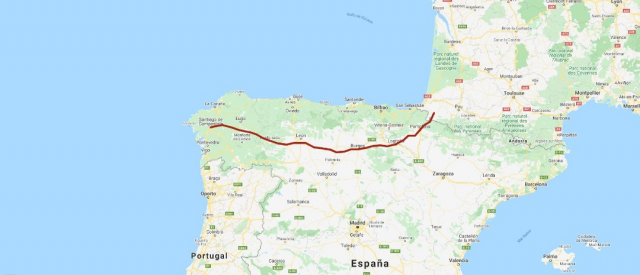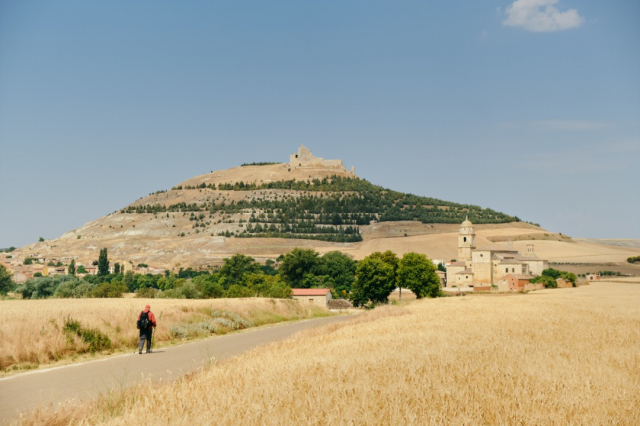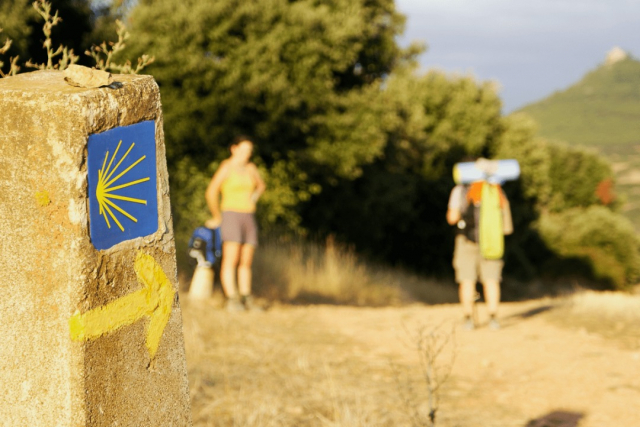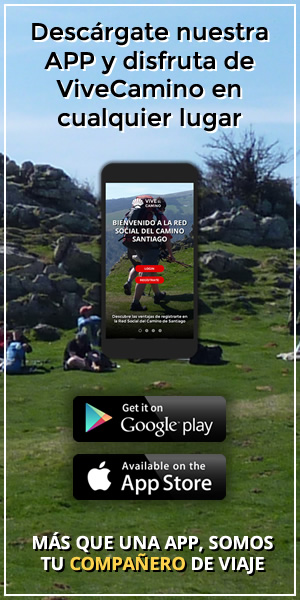Without doubt the itinerary with the most historical tradition in the Camino de Santiago. This French born route borders around the Pyrenees and Crosses the Iberian Peninsula from east to west. Approaching Galicia by the legendary climb to O Cebreiro.
French Way of Saint James: Everything you need to know about this historic route
The Way of St. James from Roncesvalles is, without a doubt, the route of the Way of St. James with the longest tradition due to its long historical route. Although the privilege of being the oldest route falls to the Primitive Way, its traces date back to shortly after the discovery of the remains of the Apostle in the 9th century.
What was christened the Main Street of Europe, a title that was endorsed in 1987 when it was declared the first European cultural route, now takes on an even more global dimension as it welcomes a greater number of ultra-Pyrenean pilgrims, who come from up to 150 different countries to follow the Way of St. James on foot, by bike or on horseback in search of the land of Compostela.
Its extraordinary historical tradition and its weight in the international arena have ensured that at the dawn of the 21st century, 20 years after its declaration as a UNESCO World Heritage Site, the French Way of St. James is reviving with a vengeance.
The French Way: History, origins and current affairs of this Jacobean route
The pilgrimage from France has continued uninterrupted since the 9th century after news of the supposed discovery of the remains of the Apostle in Santiago reached the neighbouring country and various corners of Europe. Despite the fact that the tomb, and later the Cathedral of Santiago, were located in the far west of Europe, this fact did not pose any problem for the hundreds of pilgrims who, coming from Germany, Italy and France, soon began to arrive in Compostela.
One of the first documented pilgrims, Godescalco, bishop of Le Puy, departed from France and reached the goal in 950. The Carolingian court, which claimed that Charlemagne had discovered the remains, acted as a loudspeaker for this pilgrimage route which, in the face of the scourge of Islam, was also promoted by various visionary Spanish monarchs in need of miracles and legends to encourage the Christian troops in their battles against the Muslims.
Compostela became the destination for thousands of the faithful along a route that was not without its difficulties, however, with robbers and various dangers along the way. For this reason, and as a form of help and protection for the pilgrims, kings and nobles provided the French Way of St. James with specific services for pilgrims, such as a complete healthcare network with dozens of hospitals scattered along the route, some as significant as the Hospital de San Marcos in León or the old Royal Hospital of Santiago, now the Hostal dos Reis Católicos. The Cluniac and other religious orders, such as the Templar, contributed to building monasteries and temples at the foot of the Camino, making the route a cultural and artistic highway.
Saint builders, such as Saint Domingo de la Calzada, Saint Juan de Ortega and Saint Lesmes, also helped to build bridges and causeways that made it easier for walkers to cross the natural barriers. At the same time, the kings approved the creation of new burghs along the route with their own legal statutes, many of them known as burgos francos, due to the origin of their pilgrim-moradors. Jaca, Estella and Villafranca del Bierzo are some examples.
The Codex Calixtinus, the first guide to the French Way of St. James
At the end of the 11th century, the French Way became established, something that is confirmed by the publication around 1135 of the Codex Calixtinus, a medieval guide to the pilgrimage to Santiago de Compostela attributed to the French cleric Aymeric Picaud, which describes in detail the villages, rivers, hospitals and churches that pilgrims will encounter. In the 12th century the French Way of Saint James was already a mass itinerary, with up to a thousand pilgrims arriving at Compostela every day, a figure which, however, cannot be authenticated due to the lack of documentary evidence.
The splendour of the itinerary continued until the 16th century (in 1434 the first documented Jubilee year was celebrated), although it gradually began to decline and darken. The change in mentality, harsh criticism of certain Jacobean traditions, such as the vow of St. James (an unjust medieval rent that was understood as compensation from Christian Spain for the divine support of the Apostle during the Reconquest and which served as the economic basis for the various Jacobean institutions of Santiago de Compostela) and the arrival of liberal governments to power in the 19th century all contributed to the French Way of St. James entering a period of decline, only rehabilitated by the rediscovery of the relics of the Apostle in Santiago de Compostela Cathedral in 1879 and the confirmation of the authenticity of the remains by Pope Leo XIII five years later.
The French Way, a historic symbol of European unity
In the middle of the 20th century, after the harsh post-war period, the arrival of new pilgrims began to be reported, who travelled the old route in search of this historic symbol of European unity. Associations of friends of the Camino de Santiago were founded and the route was signposted with the characteristic yellow arrows. The year 1993, a holy year, marked a turning point with the Xunta's decisive support for its recovery and the renewed interest of pilgrims in reaching Santiago, whether for religious, cultural or sporting reasons. Since then the French route has not stopped growing, with numbers that are surpassed year after year and that can become a disadvantage due to the risk of overcrowding.
However, the advantages of walking the French Way are indisputable. Its artistic values, with countless examples of the best Romanesque or Gothic art, or its environmental grandeur, which allows the walker to discover the charming French towns, the rugged Pyrenees, the fortified villages of Navarre, the wine region of La Rioja, the silent and harsh Castilian plateau, the Maragata region of Astorga or the green Galicia, are two weighty arguments. The route also passes through such outstanding towns as Pamplona, Logroño, Burgos, with its beautiful cathedral, León and enclaves with a clear Jacobean flavour such as Puente la Reina, Santo Domingo de la Calzada and Sahagún.
All the stages of the French Route from Roncesvalles
Where does the French Way of Saint James begin?
The French Way of Saint James has a precise itinerary in France, from where four branches depart. Three of them, starting in Paris-Tours, Vézelay-Limoges and Le Puy-Conques, converge in Ostabat, a town 20 kilometres from Saint-Jean-Pied-de-Port. After covering this short distance together and climbing through the Pyrenees, the pilgrims enter Spain via Roncesvalles. The fourth French route, coming from Arles-Toulouse, enters via the Somport pass and continues to Jaca, a town in the Spanish region of Aragon. Both variants will not be unified until Puente la Reina (Navarre), one of the towns with the greatest Jacobean heritage.
Which are the stages of the French Way of Saint James from Roncesvalles?
From Puente la Reina, the French Way maintains a single itinerary until the arrival in Galicia, with small variants in some sections, such as those that opt, from Sahagún, and in a minority, to continue along the ancient Roman roads. Once in Galicia, and after overcoming the legendary ascent to O Cebreiro, the pilgrims will advance in a rapid wandering through the native forests of the province of Lugo and the meadows and small mountains of A Coruña. If you set off from France, and after almost a month of pilgrimage, you will reach Santiago de Compostela.
- Stage 1: Saint Jean Pied de Port - Roncesvalles
- Stage 2: Roncesvalles - Zubiri
- Stage 3: Zubiri - Pamplona
- Stage 4: Pamplona - Puente la Reina
- Stage 5: Puente la Reina - Estella
- Stage 6: Estella - Los Arcos
- Stage 7: Los Arcos - Logroño
- Stage 8: Logroño - Nájera
- Stage 9: Nájera - Santo Domingo de la Calzada
- Stage 10: Santo Domingo de la Calzada - Belorado
- Stage 11: Belorado - Agés
- Stage 12: Agés - Burgos
- Stage 13: Burgos - Hontanas
- Stage 14: Hontanas - Frómista
- Stage 15: Frómista - Carrión de los Condes
- Stage 16: Carrión de los Condes - Terradillos de los Templarios
- Stage 17: Terradillos de los Templarios - El Burgo Ranero
- Stage 18: El Burgo Ranero - León
- Stage 19: León - San Martín del Camino
- Stage 20: San Martín del Camino - Astorga
- Stage 21: Astorga - Foncebadón
- Stage 22: Foncebadón - Ponferrada
- Stage 23: Ponferrada - Villafranca del Bierzo
- Stage 24: Villafranca del Bierzo - O Cebreiro
- Stage 25: O Cebreiro - Triacastela
- Stage 26: Triacastela - Sarria (Por San Xil)
- Stage 26B: Triacastela - Sarria (Por Samos)
- Stage 27: Sarria - Portomarín
- Stage 28: Portomarín - Palas
- Stage 29: Palas - Arzúa
- Stage 30: Arzúa - Pedrouzo
- Stage 31: Pedrouzo - Santiago de Compostela
How many kilometres separate Roncesvalles from Santiago de Compostela?
The route can be completed by walking around 25 kilometres per day. The Way of Saint James from Roncesvalles, the first Spanish town on the French Way, has a distance of 790 kilometres divided into 30 stages to reach Santiago de Compostela in the province of La Coruña.
How long is the French Way?
"How long does it take to do the Camino de Santiago?" is one of the most common questions, especially because it is an information that will help us to manage the days that we can devote to make the way as well as having everything ready for this. However, the duration of the French Way depends on the place from where we start as well as the conditions in which we do it: if we are walking, cycling or horseback riding, among other cases.
These data affect the pace at which we make the Camino de Santiago, so the duration of this depends, above all, of these previous preparations. What we can highlight is that, if we start the route from Roncesvalles, the number of days will be approximately 31 days. If you start from Saint-Jean-Pied-de-Port, your place of origin, this figure will increase slightly.
Therefore, when it comes to managing the time we can dedicate to our route, it will depend at all times on the route we want to follow, the conditions in which we do it and, above all, the pace we can maintain. Above all, remember that the important thing is to enjoy the route, the experience and always be prepared for the journey.
How difficult is the French Way through Roncesvalles?
One of the main doubts when it comes to doing this route is its difficulty. You should know that the way to do from Roncesvalles to finish the Camino de Santiago on the French Way of a medium difficulty. This is not a particularly complex section, although it has differences in altitude between sections, which can cause some problems for some pilgrims.
The most complex part is in stage 4, from Pamplona to Puente la Reina. This is because there is an ascent from Pamplona to the Alto del Perdón. Although the ascent is gentle, the altitude is high, so special care is required both when making the ascent and its descent, remembering the importance of rest and hydration, especially if the route is made in the heat of the season.
Why start the route from Roncesvalles? Its origin and history on the route
When planning the Camino de Santiago through Roncesvalles or starting in this same, we must know that in Roncesvalles is one of the most important milestones jacobeos. It is no coincidence since this, for centuries, has been presented as one of the most important points for pilgrims, ensuring their safety and providing all the necessary care to those who reached this point after crossing the Pyrenees from France. After all, it was here that the Roncesvalles complex was built at the end of the 12th and 13th centuries, which originally served as a hostel-hospital as well as the Royal Collegiate Church of Santa María.
It should be noted that Roncesvalles has always been characterised as a place of passage. The first Celts who occupied the Peninsula were here before the Romans arrived a few years later. It is worth mentioning that Charlemagne and his troops fell here against the Basques.
However, it was not only the war that made this place stand out, but also the start of the pilgrimages that brought Roncesvalles back to life. After all, it is a place where attention to pilgrims still has to be emphasised.
These characteristics cause Roncesvalles to become both a point of passage from France and, in itself, one of the most prominent points to start the Camino de Santiago. In fact, you should know that many pilgrims are encouraged to begin their journey from the French town of Saint Jean Pied de Port, being the end of this first stage Roncesvalles.
Therefore, whether you start the Camino de Santiago from Saint Jean Pied de Port or from Roncesvalles, remember that the important thing is to enjoy the road. And, of course, make the most of the experience, whether you do it by bike or with everything you need to walk.
Is it necessary to do the whole of the French Way to get the Pilgrims Credential?
Many pilgrims want to do the French Way and, however, not always have the time or what is necessary to be able to make this way. So, is it necessary to do the entire French Way to obtain the credential? It is here where we must emphasize that no, you do not have to start the way from the French province of Saint Jean Pied de Port to do so.
We must emphasize that, in order to achieve this objective, you must complete at least 100 km of the Camino. To do so, you should bear in mind that you would have to start the route from stage 27, the point that starts from Sarria. A route that must be done on foot.
In case your intention is to do the route by bicycle, this route goes up to 200 kilometres. In this case, you would need to start the route at stage 23, thus beginning your route in Ponferrada.
Why is the French Way so popular?
One aspect that we must highlight about the French Way is the fact that it is one of the best known routes in the world, if not the best known. This is due to two important aspects and is that not only stands out for its connection with Europe, which has been highlighted since Medieval Europe, but because this route was also present in the form of a guide in the Codex Calixtinus.
The Codex Calixtinus is one of the most important documents in Christianity, although its origin is still a mystery today. However, it consists of more than two hundred parchments and is divided into five books and two annexes that make it a reference for the Camino de Santiago.
Another important aspect is that not only is its origin and author unknown, but it is also unknown where the original version is to be found. Of this, only the copies are known. However, in its pages you can find all kinds of references to Santiago as well as the presence of the French Way in the form of a guide.
Besides this, do you know where the yellow signs that remind us so much of the Camino de Santiago originated? They owe their presence to Father Elías Valiña. With paint left over from some lorry drivers, he decided to mark the route of the French Way with the signs. These, today, not only stand out for their importance, but also for becoming a symbol and seal of the Camino de Santiago.
French Way: The most complete network of hostels on the Way of St. James
Other pilgrims are also attracted by the historical and legendary feats that mark the route, such as those of Charlemagne's court or those of the Cid, or by the many legends that make it epic and that even see in it the origins of the popular game of the goose, with its successive squares.
In addition, and unlike other routes, the Camino de Santiago from Roncesvalles is accompanied by a complete network of hostels, a precise signposting of stages of the French Way (beyond the picaresque that tries to divert the route to private businesses), multiple services adapted for walkers and many localities involved in the itinerary (such as Sarria, the most chosen starting point for pilgrims on this route), its main and almost only source of income.
For all these reasons the effect on this pilgrimage route overcomes barriers and crosses cultures, it is an experience that is enjoyed to the fullest whether you travel accompanied as if you decide to do the Camino de Santiago alone. Be that as it may, if it is the first time that you are going to do it and you do not have previous experience, be sure to take a look at our tips for doing the Camino de Santiago, with everything you need to know before leaving to make your experience unforgettable.
Buen Camino.
Routes
Blog
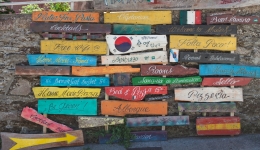 How to get to Sarria to do the Camino de Santiago
How to get to Sarria to do the Camino de Santiago
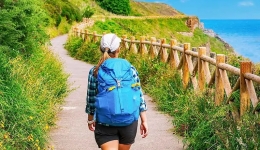 Descubre la magia del Camino de Santiago Portugués por la costa
Descubre la magia del Camino de Santiago Portugués por la costa
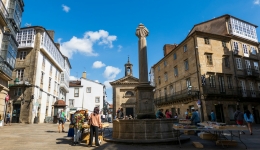 5 tours culturales que puedes hacer en Galicia si decides hacer un alto en el camino
5 tours culturales que puedes hacer en Galicia si decides hacer un alto en el camino
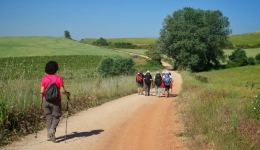 Doing the Camino de Santiago in June: What you should know?
Doing the Camino de Santiago in June: What you should know?
Information
Points of interest
Cities & Towns | Hostels | Lodgings | Restaurants | Saddlery | Doctors | Points of interest | Bikes workshop
Contact us | Privacy policy | Cookies policy | | Terms of use | Authorship | Web Map | Consentimiento
© Copyright LA VOZ DE GALICIA S.A. Polígono de Sabón, Arteixo, A CORUÑA (ESPAÑA) Inscrita en el Registro Mercantil de A Coruña en el Tomo 2438 del Archivo, Sección General, a los folios 91 y siguientes, hoja C-2141. CIF: A-15000649
Developed and managed byHyliacom
